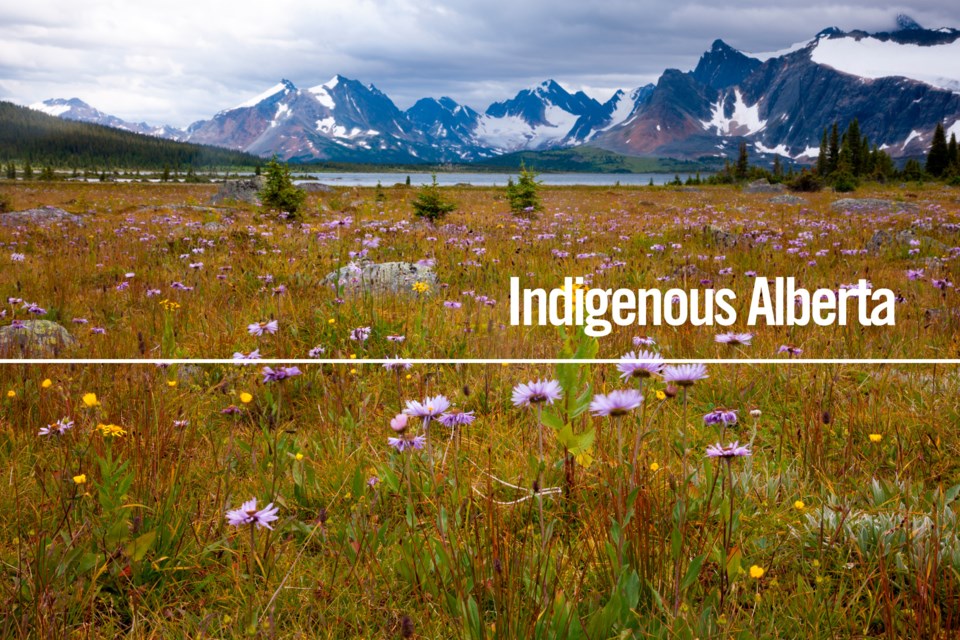Mother Earth: Plants for Health and Beauty is the title of a new book by Carrie Armstrong, a Cree/Métis teacher turned wellness product maker, who uses traditional plant knowledge to craft her teas, soaps, and essential oils.
Her online store, Mother Earth Essentials, has been popular for more than a decade, but saw its biggest year in sales ever last year after COVID-19 hit.
“A lot of the things that I share, especially around culture, are things that I was taught by one of our local Elders, Francis Whiskeyjack, who I worked with for a long time. So, I share stuff based on his teachings,” said Armstrong.
Her book is filled with stories from her own past, as well as stories about the plants themselves. And there are parts of poems, prayers, and profound words from other writers, organizations like the Anasazi Foundation (a wilderness healing camp based in Arizona), and notable Indigenous people like Chief Dan George.
The photos give the book a colorful touch.
Armstrong’s book opens with a story about her mother and aunts being taken from her grandmother and put in residential school.
“This greatly impacted the family and contributed to the shame we all felt about our Indigenous background,” she writes.
“My grandmother struggled with fears that her grandchildren would also be taken away. She hid her cultural wisdom from most people, but when I was with my grandmother out in nature, her true self shone through. She taught me about the power of healing plants, teachings that had been passed down to her from her mother and grandmother.”
Her grandmother was “an intuitive woman and a natural healer,” she goes on to say.
The book also features a special prayer Armstrong said is really what she has based most of her work on, as a teacher at amiskwaciy Academy in Edmonton, where she worked with Whiskeyjack, as well as her work in wellness retail.
The prayer is by Solomon Ratt, Woods Cree speaker and educator. It pays homage to the four directions, for which you put down a different plant offering—tobacco, sage, sweetgrass, and cedar—and ask for a key quality—tolerance, kindness, love and patience—one for each of four age categories.
And she has two favorite stories in the book, as well.
The first is a story of how just smelling and touching fresh mint had an impact on a youth she was working with. Prior to that moment, he had been unreachable and sat in the back of her classroom with his cap down, not paying any attention to her or the lessons at hand, she said.
Because of the mint, something within him was awakened, and Armstrong could hardly believe it was all because of a plant.
“It was the first time we connected…. And he had these big tears in his eyes, and he looked at me and said, ‘My Kokum used to give me that when I was sick.’ And it seemed to be a very powerful moment because just that smell reminded him of so many good things. It reminded him of his grandma, his healing, his community, the teachings, Mother Earth, the miracle of the medicine of plants…” said Armstrong.
“So many things happened in that moment, and it even helped create a relationship with this young man so I could actually teach him,” she added.
Her other favorite story is about the power of the willow tree, titled Willow Wisdom in the book.
She is a survivor of domestic violence, and the willow tree brought her a teaching that helped her recover from that trauma.
“I came out of a very dark place before I wrote the book. I was in a very violent marriage. And I was in a pit, and I was not feeling very strong or very confident. It took a toll on me…. And the book was extremely healing for me to write. I poured myself into it and it felt extremely therapeutic,” she said.
“The willow tree can survive and thrive in some of the harshest conditions. The willow taught me that I had the ability to be strong and to grow, yet still remain flexible,” she writes in the story.
It was her therapist, according to the story, who brought her to connect with the willow tree near her office. And that was a moment in which she found herself again, as well as courage and strength, she writes.
That story Is preceded by a recipe for a willow bark facial treatment, one of many beauty recipes in the book.
Armstrong emphasizes that she makes no claim of being a medicine person herself. She teaches only physical properties of the plants she works with, and leaves the spiritual knowledge of the plants to Elders and wisdom keepers. And she leaves contraindications of plant medicines to doctors, noting that she does not have this knowledge base and would never claim to.
Next up, she has a coloring book coming out, with plants to color, and information on each plant. The centre fold-out is the same Christy Belcourt painting featured on the cover of the Mother Earth Plants book.
Armstrong is grateful to have been granted permission by Belcourt to use her artwork. The title, She Who Stands Tall, is very suiting, she said.
Mother Earth Plants is available online, as well in hard copy through her store, and through stores like Indigo-Chapters and Amazon.
Andrea Smith, Local Journalism Initiative Reporter
Read more from WindSpeaker.com



